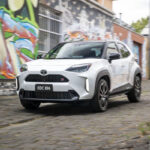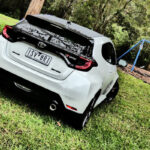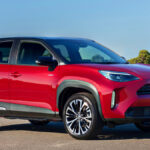Toyota Yaris is a smaller brother to the big selling Corolla and is aimed at those primarily driving in the city and suburbs. It can be used on country trips, though you’re probably best to keep clear of unsealed roads. Even rough sealed surfaces can challenge the suspension and the ride can be pretty bumpy on occasions.
It’s one of the top sellers in its class so there are plenty on sale at any one time. Use this to your advantage by picking and choosing between those on offer.
Yaris was introduced to Australia in 2005, in this review we are looking at the second generation that went on sale in October 2011. It’s significantly larger and more refined than the ’05 model and is our recommendation if you can come up with the extra folding stuff.
The great majority of these small Toyotas are five-door hatchbacks. A three-door hatch was offered initially but was pulled off the new-car market due to lack of interest with the facelift of the Yaris in August 2014.
A four-door sedan was discontinued with the introduction of the gen-two, but Toyota kept the first generation sedan on sale alongside the gen-two for a while. These weren’t exactly popular, indeed they’re pretty rare beasts – but we don’t anticipate them ever becoming rare collectors’ cars…
Yaris’ boot is on the small side as this is the area that suffers in the people/luggage compromise in most small cars. Check for yourself early in your pre-purchase stage as individual needs vary greatly.
Handling of the little Toyota is safe but not exactly inspiring. Some suspension work was done in Australia by local and Japanese engineers to suit local tastes. But sensibly there’s a leaning towards comfort ahead of sportiness. Which is a good thing as it’s unlikely many will have been thrashed by keen drivers.
Having said that, there’s a semi sporty model, Yaris ZR, that might be worth chasing if you’re looking for something more to your taste.
Safety is advanced, with even the oldest models being examined here having electronic aids to help keep drivers out of trouble. This further improved in stages, with the facelifted 2014 and 2017 models being up with those in much more expensive cars.
Power comes from four-cylinder engines of 1.3- or 1.5-litre capacity. Five-speed manuals and four-speed automatics are offered.
The smaller engine may seriously be lacking in performance if you’re carrying a big load in twisting mountainous roads, especially if it’s an automatic.
March 2017 saw Yaris getting another facelift and tail tuck that squared off its shape to bring it into line with its larger brothers.
A good home mechanic will be able to do a lot of the work that doesn’t affect the safety of the car. Underbonnet room is understandably tight so expect some frustration and bloodletting.
There are Toyota dealers all over Australia, even in very remote regions. Outback dealers may not have parts in stock for the Yaris, meaning you may have to wait for them to be freighted up from the city, something that usually only takes a couple business days.
Spare parts are pretty reasonably priced and we have never heard any real complaints about availability.
Insurance costs are generally good and there doesn’t seem to be a great variation from company to company. Nevertheless it’s still smart to shop around, always make sure you’re doing an accurate comparison.
WHAT TO LOOK FOR
Sun fading on the interior trim is likely to mean a car has spent most of its life parked outdoors.
Look over the interior of a car and boot for damage caused by careless kids.
Check for damage to the body or signs that it has been repaired. Looking sideway along the panels will show up ripples if the work hasn’t been done correctly.
Look at the lower mounting of the rear safety belts, some may have caused damage to the webbing of the belts.
Toyota seems to have brake fluid leaks on disc brakes from time to time, the Yaris is no exception. Have it repaired immediately as fluid on the discs drastically reduces effectiveness.
Make sure the engine starts promptly, idles smoothly, accelerates without hesitation and doesn’t blow smoke when worked hard.
Manual gearboxes should be smooth and quiet in operation and not clash gears. Fast downchanges from third to second are usually the first ones to play up.
Automatics should be smooth in their changes without any delay in going into gear from Neutral or Park.
HOW MUCH?
Expect to pay from $3000 to $5500 for a 2011 Toyota Yaris YR; $5000 to $8500 for a 2012 YRS or a 2014 YR; $7000 to $11,000 for a 2014 YRX or a 2016 YRS; $9000 to $14,000 for a 2014 ZR; $10,000 to $15,000 for a 2016 ZR or 2018 SX; and $13,000 to $19,000 for a 2018 ZR.
CAR BUYING TIP
Some cars have a reputation for being bulletproof. But don’t let this be an excuse to save money by not having a full inspection.
RECALLS: To browse recalls on all vehicles go to the ACCC at: www.productsafety.gov.au/products/transport/cars/














